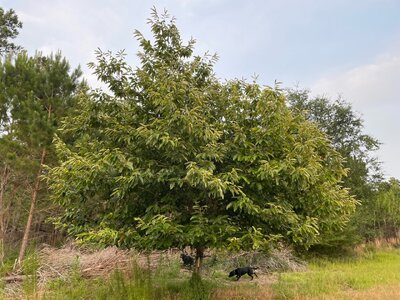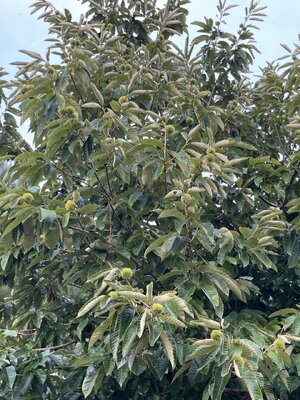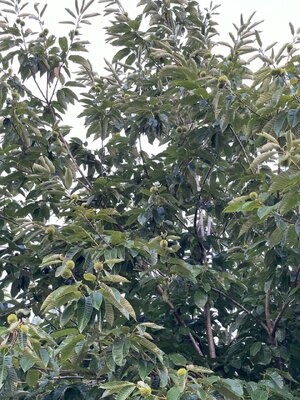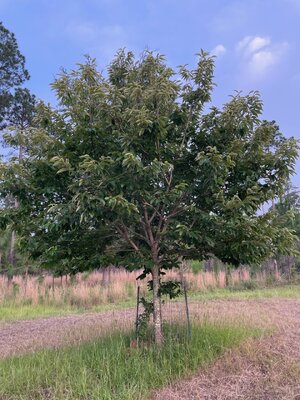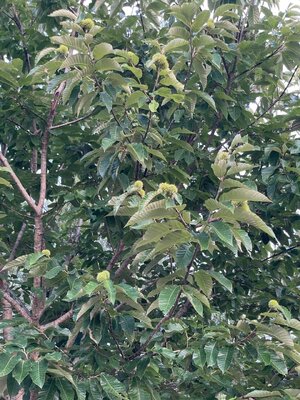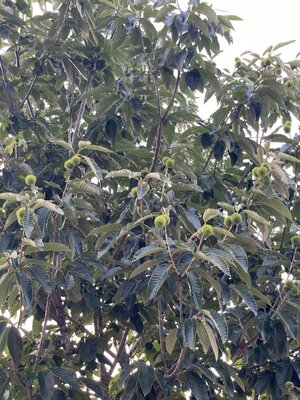-
The forum has been upgraded to support both light and dark themes. Click here for directions.
You are using an out of date browser. It may not display this or other websites correctly.
You should upgrade or use an alternative browser.
You should upgrade or use an alternative browser.
Chestnut Production?
- Thread starter KSQ2
- Start date
wbpdeer
Well-Known Member
As the climate and rainfall changes from location to location (state to state) so does the results. K2Q2, nature is in charge and has the final say on the outcome in habitat management even when we do everything right on our side of the process.Ours went in the ground 8 years ago and look NOTHING like that. Oh well, I’ve never been good with trees of any kind. Hopefully they will catch up one day.
Don't beat yourself up. Cutman needs to share some of that rainfall, his trees do look great!!!
wbpdeer
I’m definitely pleased with these chestnuts. More importantly, the deer really started to focus on them last deer season. I watched one buck go camp out under each tree daily.
Here they are when purchased in 2014.
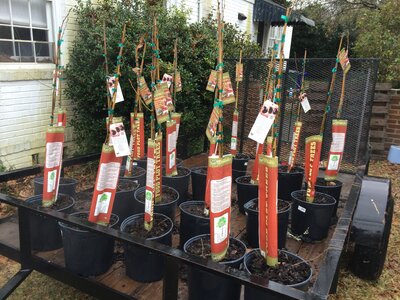
Interestingly, the AU buck chestnuts from The Wildlife Group were a complete failure. They never amounted to anything and slowly died off.
Here they are when purchased in 2014.

Interestingly, the AU buck chestnuts from The Wildlife Group were a complete failure. They never amounted to anything and slowly died off.
yoderjac
Well-Known Member
I had the same experience with AU Buck III and IVI’m definitely pleased with these chestnuts. More importantly, the deer really started to focus on them last deer season. I watched one buck go camp out under each tree daily.
Here they are when purchased in 2014.
View attachment 25562
Interestingly, the AU buck chestnuts from The Wildlife Group were a complete failure. They never amounted to anything and slowly died off.
wbpdeer
Well-Known Member
I have a fear that the late freezing weather gonna reduce the production in some of the best orchards in the country. I buy from Route 9 Cooperative every fall.If you're interested in starting from seed, check out Route 9 coops wildlife hybrid trees. Nuts go on sale in the fall and sell quickly.
Native Hunter
Well-Known Member
I have tip for you chestnut growers - if you have a clover plot next to a chestnut tree and haven't mowed the plot this year, you might find some little treasures coming up about this time. I just happened to notice 9 little chestnut sprouts coming up in my plot today. They will be easy to transplant.
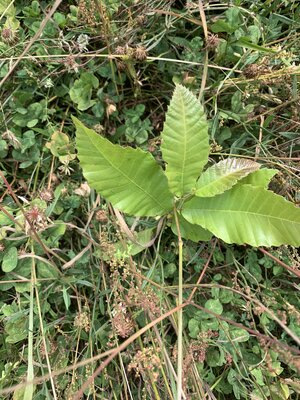

wbpdeer
Well-Known Member
Native Hunter,
I walk soon after daylight thru the yard to check on trees this time of year, as well as the seedlings I am growing. My yard had been cut 8 days before when I discovered for the 1st time ever, eight volunteer chestnuts had popped up. I marked all 8 with green flags. I put my mowing crew on notice, and I have allowed these to go past one mowing already.
I will do one more skip, then I will dig these up. The 8 happened to pop up between my back door and the greenhouse. Free seedlings, which I have watered a few times to give them some help. Today, 7 of the 8 show some red new growth as young seedlings do.
This occurrence has never happened before in my yard, so 2023 ain't all bad (late freeze gonna hurt my nut production).
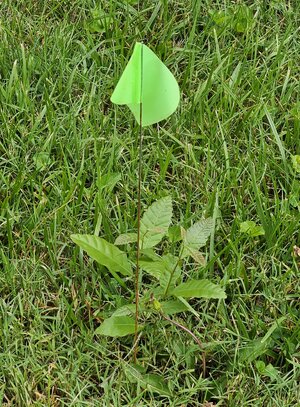
I walk soon after daylight thru the yard to check on trees this time of year, as well as the seedlings I am growing. My yard had been cut 8 days before when I discovered for the 1st time ever, eight volunteer chestnuts had popped up. I marked all 8 with green flags. I put my mowing crew on notice, and I have allowed these to go past one mowing already.
I will do one more skip, then I will dig these up. The 8 happened to pop up between my back door and the greenhouse. Free seedlings, which I have watered a few times to give them some help. Today, 7 of the 8 show some red new growth as young seedlings do.
This occurrence has never happened before in my yard, so 2023 ain't all bad (late freeze gonna hurt my nut production).

Native Hunter
Well-Known Member
Native Hunter,
I walk soon after daylight thru the yard to check on trees this time of year, as well as the seedlings I am growing. My yard had been cut 8 days before when I discovered for the 1st time ever, eight volunteer chestnuts had popped up. I marked all 8 with green flags. I put my mowing crew on notice, and I have allowed these to go past one mowing already.
I will do one more skip, then I will dig these up. The 8 happened to pop up between my back door and the greenhouse. Free seedlings, which I have watered a few times to give them some help. Today, 7 of the 8 show some red new growth as young seedlings do.
This occurrence has never happened before in my yard, so 2023 ain't all bad (late freeze gonna hurt my nut production).
View attachment 25566
That's great Wayne. I also find some good Sawtooth seedlings from time to time. I actually built a temporary cage out of a roll of welded wire just to plant different stuff I find when I'm out working. That keeps them safe until later when I have time to actually put them where they need to be.
KSQ2
Well-Known Member
Those who grow chestnuts from seed successfully and keep them in containers for a couple years, please explain your strategy and how you’re keeping older trees from becoming irreversibly root bound. I’d really like to do the same; one year old trees haven’t done well when out on the farm, where they can’t be babied, in my experience.
yoderjac
Well-Known Member
You need to use a root pruning system of containers like Rootmaker or something similarThose who grow chestnuts from seed successfully and keep them in containers for a couple years, please explain your strategy and how you’re keeping older trees from becoming irreversibly root bound. I’d really like to do the same; one year old trees haven’t done well when out on the farm, where they can’t be babied, in my experience.
wbpdeer
Well-Known Member
As Yoder says, many of us go the rootmaker route and then move them to larger containers so they can grow healthy into their 2nd year. At the point you plant them into their final location, they have good girth on the stem and a root system that drives the train thru stressful times.Those who grow chestnuts from seed successfully and keep them in containers for a couple years, please explain your strategy and how you’re keeping older trees from becoming irreversibly root bound. I’d really like to do the same; one year old trees haven’t done well when out on the farm, where they can’t be babied, in my experience.
I have used a product sold by the Wildlife Group in Alabama, called moisture miser that retains about 1,000 times it's weight in water, then releases the water in periods of extreme dryness. It appears to a science fiction clear glob stuff when it retains the water. I spilled some once on the farm and the next time I saw it laying on the ground it was amazing how much of a mass it had changed into.
Sprinkle that into the planting hole as you back fill the dirt. The photo below is a 5-gallon bucket with two-year chestnuts. Zoom in to see the girth on some of the stems. Huge difference over a 1st year seedling.
I use Osmocote Plus, a slow release fertilizer, with all my seedlings. It has 11 nutrients as the plus part. I refuse to pot anything if I am out of these stuff, to me it is that important. This year I have added alpaca compost to pots mix. My chestnuts and acorns love this too.
Attachments
Last edited:
What is alpaca compost?As Yoder says, many of us go the rootmaker route and then move them to larger containers so they can grow healthy into their 2nd year. At the point you plant them into their final location, they have good girth on the stem and a root system that drives the train thru stressful times.
I have used a product sold by the Wildlife Group in Alabama, called moisture miser that retains about 1,000 times it's weight in water, then releases the water in periods of extreme dryness. It appears to a science fiction clear glob stuff when it retains the water. I spilled some once on the farm and the next time I saw it laying on the ground it was amazing how much of a mass it had changed into.
Sprinkle that into the planting hole as you back fill the dirt. The photo below is a 5-gallon bucket with two-year chestnuts. Zoom in to see the girth on some of the stems. Huge difference over a 1st year seedling.
I use Osmocote Plus, a slow release fertilizer, with all my seedlings. It has 11 nutrients as the plus part. I refuse to pot anything if I am out of these stuff, to me it is that important. This year I have added alpaca compost to pots mix. My chestnuts and acorns love this too.
How do you use it?
bill
wbpdeer
Well-Known Member
An alpaca is an animal similar in appearance to a Llama. There is a man in my county that has an alpaca farm. They show their animals and harvest the wool from their coats. He sells the compost $25 per loader scoop with his tractor bucket. Two scoops fill my pull trailer just right. My trailer is 83 inches by 100 inches.What is alpaca compost?
How do you use it?
bill
I tested it as an additive to my growing media on about a dozen seedlings. when it was time to move them up to a larger growing container. After one month it was obvious that they liked it as their leaves were a very healthy green and stems were nice looking. Some people make a compost tea with putting the compost in a strainer bag and adding an aerator to the water to increase the good stuff growth.
I let nature take care of that as I spread it under 5 nut producing chestnut trees in my yard and 3 producing sawtooth in my yard.
Also, a friend purchased a new farm and I planted 9 seedlings total for him (chestnut & sawtooth) and used this compost as a mulch on the ground. I will go back after this week of rainfall in our area and top dress that area around those seedlings with pine straw to less the evaporation. Pine straw helps the pH for acid loving trees.
I hope this explanation helps.
yoderjac
Well-Known Member
Keep in mind that chestnuts don't like wet feet. When growing them in root pruning containers, watering is one of the most critical parts. You need a well drained, chunky mix with lots of voids for roots to fill. They need to be saturated and then allowed to dry out. I like to water by weight. After first planting a nut or tree in a new container full of mix (promix works well), pick up the container and get a feel for the weight. Then drench it with water until it is draining out the bottom holes in the container, and pick it up again and feel the weight. If you think of the first weight as the tank is empty and the second weight as the tank is full, I like to water when the tank is on 1/4 full. If the leaves begin to droop, water immediately, you waited too long.
Another big consideration is your soil when planting chestnuts. Watersorb or similar products as Wayne mentions can be great for sandier soils in dryer climates. I have heavy clay soils and it took me a while to find a good planting technique in clay. The issue is the difference in infiltration between the chunky mix you use in root pruning containers, and clay. When you put this mix into a hole in clay, you are effectively creating a pond. During wet times the roots are inundated with water and during dry times water evaporates quickly from the mix.
My technique is to use a 3-pt hitch auger that is very close in diameter to a 3 gal rootbuilder II container which is the size I get the best results from as the final stage before planting. I auger the hole much deeper than the container. I use a hand rake to scarify the sides of the hole to remove any glazing of the clay. I then backfill the hole with quarry stone and put a little native soil on top of that so the hole is almost as deep as the container. I then place the tree with the mix in the hole. The fit is so tight I have to stand on it to get it into the hole. I leave the mix about 1" above the hole and then mound clay over it forming a ramp away. You need be sure the planting spot is not in a low spot where ground water can run in. The clay mounding further helps keep ground water out.
In my climate we get good rain in the spring. During this time the ponding forms in the quarry stone below the root ball so the tree does not drown. Our summers can be dry, but because the hole is so tight, and root maker trees don't have the years of sleep, creep, and then leap like bare root trees, the lateral roots have had time to penetrate the clay which retains moisture well.
This technique, and root pruned trees in general, may not be a good fit for all areas. With sandy soil, water retention is more important and ponding is not a factor. In more arid regions direct seeding may be a better choice.
I don't do any after care with my wildlife trees once they are planted and protected. I did my chestnuts in volume so trees need to survive and produce on their own without special care. If you are only planting a few trees and have time for after care, I'm sure you can get faster production. I have food plots for fast production. With trees like chestnuts, I'm playing the long game.
Another big consideration is your soil when planting chestnuts. Watersorb or similar products as Wayne mentions can be great for sandier soils in dryer climates. I have heavy clay soils and it took me a while to find a good planting technique in clay. The issue is the difference in infiltration between the chunky mix you use in root pruning containers, and clay. When you put this mix into a hole in clay, you are effectively creating a pond. During wet times the roots are inundated with water and during dry times water evaporates quickly from the mix.
My technique is to use a 3-pt hitch auger that is very close in diameter to a 3 gal rootbuilder II container which is the size I get the best results from as the final stage before planting. I auger the hole much deeper than the container. I use a hand rake to scarify the sides of the hole to remove any glazing of the clay. I then backfill the hole with quarry stone and put a little native soil on top of that so the hole is almost as deep as the container. I then place the tree with the mix in the hole. The fit is so tight I have to stand on it to get it into the hole. I leave the mix about 1" above the hole and then mound clay over it forming a ramp away. You need be sure the planting spot is not in a low spot where ground water can run in. The clay mounding further helps keep ground water out.
In my climate we get good rain in the spring. During this time the ponding forms in the quarry stone below the root ball so the tree does not drown. Our summers can be dry, but because the hole is so tight, and root maker trees don't have the years of sleep, creep, and then leap like bare root trees, the lateral roots have had time to penetrate the clay which retains moisture well.
This technique, and root pruned trees in general, may not be a good fit for all areas. With sandy soil, water retention is more important and ponding is not a factor. In more arid regions direct seeding may be a better choice.
I don't do any after care with my wildlife trees once they are planted and protected. I did my chestnuts in volume so trees need to survive and produce on their own without special care. If you are only planting a few trees and have time for after care, I'm sure you can get faster production. I have food plots for fast production. With trees like chestnuts, I'm playing the long game.
This. Personally, I'd start with the 1 gallon containers or bags, and then move to 3 gallon. I haven't had the best luck with the RM18 cells, as they dry out too fast.You need to use a root pruning system of containers like Rootmaker or something similar
RE potting mix, look at the professional stuff. ProMix BK and BRK is ideal for trees.
When it comes to starting chestnuts from seeds, DO NOT OVER WATER. Also, water the base only. DO NOT WET the young leaves, or you'll likely get die back.
yoderjac
Well-Known Member
This. Personally, I'd start with the 1 gallon containers or bags, and then move to 3 gallon. I haven't had the best luck with the RM18 cells, as they dry out too fast.
RE potting mix, look at the professional stuff. ProMix BK and BRK is ideal for trees.
When it comes to starting chestnuts from seeds, DO NOT OVER WATER. Also, water the base only. DO NOT WET the young leaves, or you'll likely get die back.
You need to watch water carefully with 18s, but they are an important step for maximum production. My previous post describes watering by weight. You are spot on with Promix. The purpose of 18s is to prune the tap root at about 4". Studies show that most of the upstream lateral root production occurs in the first 4" before the prune. That is why I said container system. I started my nuts indoors under lights in the winter as a cabin fever project. The 18s are good for 12-16 weeks. Osmocote Plus works well when fertilizing in containers. I tried to time mine so that my transplant to 1 gal RB2s occurs about the time our threat of frost goes away so I can begin to slowly acclimate my trees to sun outside.
One more transplant tip: When you first put a nut or tree in a container, water quickly drains out of the bottom holes of the container when it is top watered. As the roots fill the voids, it will take more time for the water to drain out. Eventually, you will need to ad a little water, let it soak in, add more, let that soak in, and repeat the process until eventually it drains out the bottom. When they get hard to top water like this, it is time to transplant.
One more tip on water. If at all possible, use rain water. City water is problematic for chestnuts in most places. In some places well water will work, but rain water is best.
I've had almost zero success planting directly from 18s. Almost every tree dies. I've had OK success planting from 1 gal RB2s. Most trees survive and some will flourish. When I field plant after the roots have filled 3 gal RB2s, all trees survive and most flourish.
Here is a tree that was started under lights in the winter, was transplanted to a 1 gal RB2 in mid-April, was transplanted again to a 3 gal RB2 in july, and planted the following Feb:
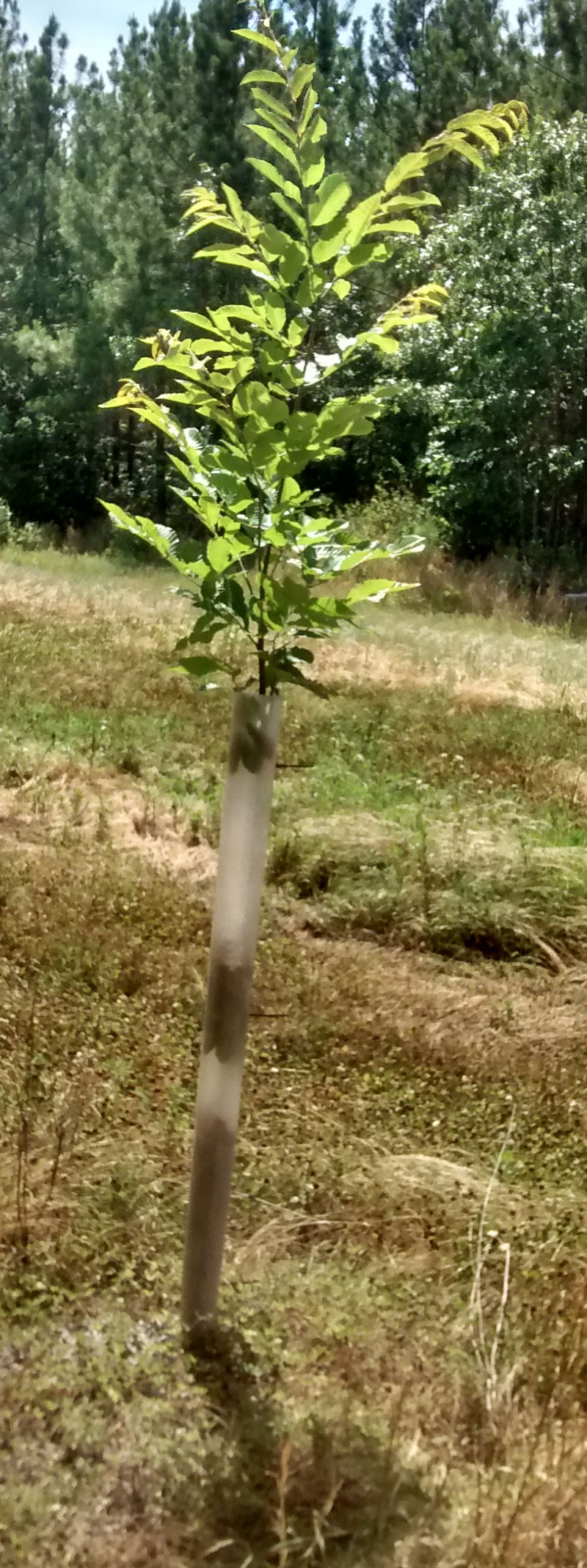
Here is the same tree after 1 year growth in the field:
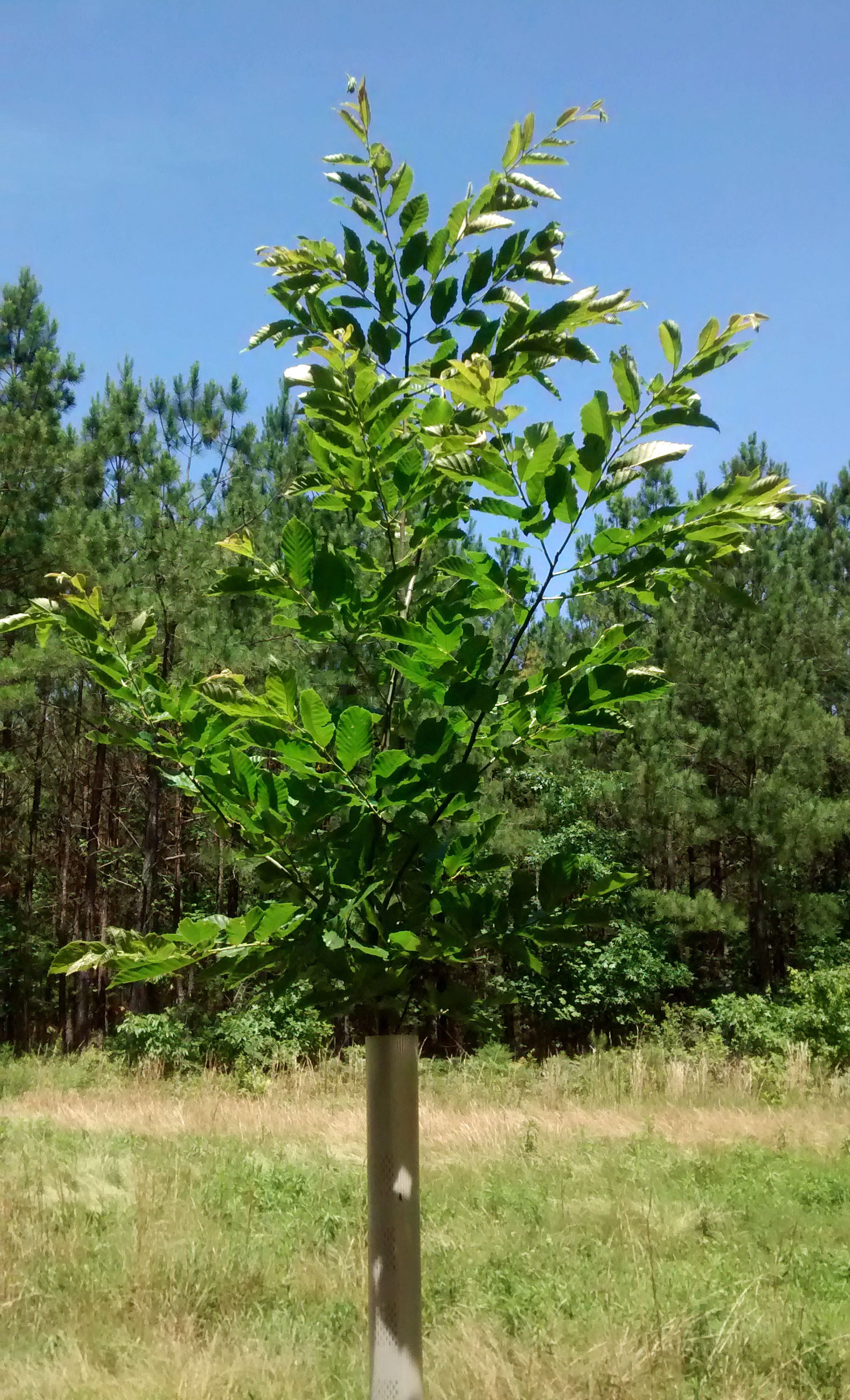
Last edited:

